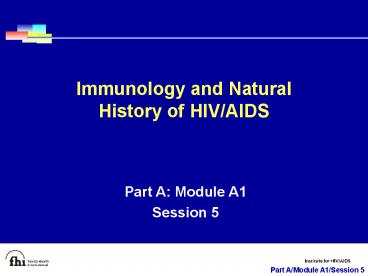Immunology and Natural History of HIV/AIDS - PowerPoint PPT Presentation
1 / 15
Title:
Immunology and Natural History of HIV/AIDS
Description:
Within five days of exposure, infected cells make their way to lymph nodes and ... Infections commence and persist or increase as the CD4 cell count drops ... – PowerPoint PPT presentation
Number of Views:1600
Avg rating:3.0/5.0
Title: Immunology and Natural History of HIV/AIDS
1
Immunology and Natural History of HIV/AIDS
Part A Module A1 Session 5
2
Objectives
- Understand how the normal immune system works
- Describe the HIV lifecycle and its effect on the
immune system - Describe the stages of disease progression,
including symptoms, laboratory findings and
management of primary infection and seroconversion
3
The Normal lmmune System
- Protects the body
- Consists of lymphoid organs and tissues
- All of its components are vital in the production
and development of lymphocytes - B-cells and T-cells are produced from stem cells
in the bone marrow - B-cells recognize specific antigen targets and
secrete specific antibodies
4
The Normal lmmune System, continued
- T-cells regulate the immune system and kill cells
that bear specific target antigens - CD4 cells are helper cells that activate
B-cells, CD8 and macrophages when a specific
antigen is present - Phagocytes include monocytes and macrophages
- The complement system consists of 25 proteins
- When the immune system is weakened or destroyed
by a virus such as HIV, the body is vulnerable to
opportunistic infections (OIs)
5
Human Immunodeficiency Virus
- HIV is a retrovirus that uses its RNA and the
hosts DNA to make viral DNA. It has a long
incubation period.
- HIV causes severe damage to and eventually
destroys the immune system by utilizing the DNA
of CD4 lymphocytes to replicate itself,
destroying the CD4 lymphocyte.
6
HIV Lifecycle
- Host cells infected with HIV have a very short
lifespan. - HIV continuously uses new host cells to replicate
itself. - Up to 10 million individual viruses are produced
daily. - During the first 24 hours after exposure, the
virus attacks or is captured by dendritic cells
(type of phagocyte) in mucous membranes and skin.
- Within five days of exposure, infected cells make
their way to lymph nodes and then to the
peripheral blood, where viral replication becomes
very rapid.
7
HIV Lifecycle
- Phases binding and entry, reverse transcription,
replication, budding, and maturation
Reverse Transcriptions Act Here
Protein Inhibitors Act Here
6. Release
3. Transcription
1. Attachment
7. Maturation
2. Entry
4. Integration
5. Polyprotein Production
8
Natural History The Chronology of HIV-Induced
Disease
- Primary HIV Infection and Seroconversion
- Clinical features
- Seroconversion illnesses
- Stages of Disease Progression
- Early immune depletion
- Intermediate immune depletion
9
Primary HIV Infection and Seroconversion
- Clinical Features
- On first exposure, there is a 2-4 week period of
intense viral replication before the onset of an
immune response and clinical illness. - Acute illness lasts from 1-2 weeks and occurs in
53 to 93 of cases. - Clinical manifestations resolve as antibodies to
the virus become detectable in patient serum. - Patients then enter a stage of asymptomatic
infection lasting months to years.
10
Primary HIV Infection and Seroconversion,
continued
- Seroconversion Illness
- Manifests as a flu-like syndrome fever, myalgia,
etc. - Neurological symptoms HIV in CSF, aseptic
meningoencephalitis, etc. - Gastrointestinal symptoms mucocutaneous
ulceration, pharyngeal edema, etc. - Dermatological symptoms rash, urticaria, etc.
11
Primary HIV Infection and Seroconversion,
continued
- Laboratory Findings
- First 1-2 weeks
- Profound reduction in CD4, CD8 lymphocyte counts
- Peripheral lymphocytosis
- Mild thombocytopenia
- First 2-6 weeks
- Antibodies to HIV detected
- HIV antigen may be detected in serum before
antibodies
12
Primary HIV Infection and Seroconversion,
continued
- Management
- Clinical management is primarily symptomatic
- Goal is to give appropriate counseling and
education to prevent further spread - Issues to consider
- Tentative nature of diagnosis
- Patients self-reproach
- Implication for patients lifestyle
- Contact tracing to identify source
13
Stages of Disease Progression
- Early Immune Depletion (CD4 cell count gt 500/mL)
- During this stage, level of virus in blood is
very low - HIV replication taking place mostly within lymph
nodes - Generally lasts for five years or more
- Persistent Generalized Lymphadenopathy (PGL)
without other symptoms may be noted - Usually symptom-free, but several autoimmune
disorders may appear
14
Stages of Disease Progression, continued
- Intermediate Immune Depletion
- (CD4 cell count between 500 and 200/ mL)
- Immune deficiency increases
- Infections commence and persist or increase as
the CD4 cell count drops - Consider commencing first-line ARV therapy
- Consider preventive treatment for TB and
Cotrimoxazole PT - Less severe infections, particularly of skin and
mucosal surfaces, appear - Other infections begin to manifest
15
Stages of Disease Progression, continued
- Advanced Immune Depletion (CD4 cell lt200/ mL)
- Case definition of AIDS is having a CD4 cell
count of less than 200/ mL

